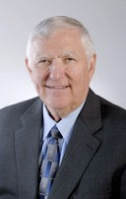
Hooves pound against the dirt road, a cloud of dust billowing up in their wake. A road-weary stranger rides into town on an equally weary horse.
Church is in session.
As Gary Moore prepared to give a lecture on the history of camp meetings for the last season’s Oliver Archives Heritage Lecture Series, he kept stumbling across accounts from the preachers involved in these large-scale religious gatherings; circuit riders who rode across the United States delivering sermons to rural areas.
“They would tell some stories that were quite interesting,” he said, “to say the least.”
This led Moore, a professor emeritus at North Carolina State University’s School of Agricultural and Human Sciences, to dive into further research on circuit rider preachers.
“I started pulling out humorous and funny stories, and sometimes sad stories, documenting the life of the circuit rider preacher,” he said.
Moore will discuss these stories at 3:30 p.m. Friday, August 16 in the Hall of Christ in his Heritage Lecture, “Circuit Rider Preachers: True Stories.”
Moore said circuit rider preachers sprang up in the early 1800s, as white Americans moved further into the West and settled towns with no established churches.
“Religion was somewhat scarce,” he said. “So the Methodists developed a system of having circuit rider preachers that would cover a 200- to 500-mile circuit.”
Circuit riders, typically young men, would ride horseback from village to village in their assigned territories delivering sermons.
“They would preach every day of the week,” Moore said. “They would preach in courthouses, barns, out in the open, any place they could find a group of people to preach (to).”
Riding a circuit took two to three weeks, and once complete, circuit riders would start all over again.
“It was a rough life,” Moore said.
Circuit rider preachers dealt with hazardous, grueling conditions. They were threatened by everything from rough terrain to roadside thieves and relied on strangers in the towns they came across for food and shelter.
“Often you would be spending the night with somebody of a different religion, and there would be bedbugs and lice and poor sleeping accommodations,” he said.
He said Chautauqua is “quasi”-connected to the circuit rider movement. Methodist bishop and Institution co-founder John Heyl Vincent got his start on the circuit.
“People may not know that,” Moore said. “Before he became a bishop, he was a circuit rider.”
Although the best-preserved diaries and accounts of life as a circuit rider preacher come from Methodists, many denominations used the same preaching method.
“There were Baptists, Presbyterians, Lutherans,” he said. “I have even found Catholic and Jewish circuit riders … (and) a female circuit rider.”
Moore said that as difficult as things sometimes were for these preachers, they were doing what they believed to be necessary.
“They led a hard life, but they were very dedicated,” Moore said. “You look at rural America in the 1800s, or even the 1900s, and it’s pretty sparsely settled in spots. And there’s no room for churches; they haven’t been established yet and circuit riders had to go where the people are.”




